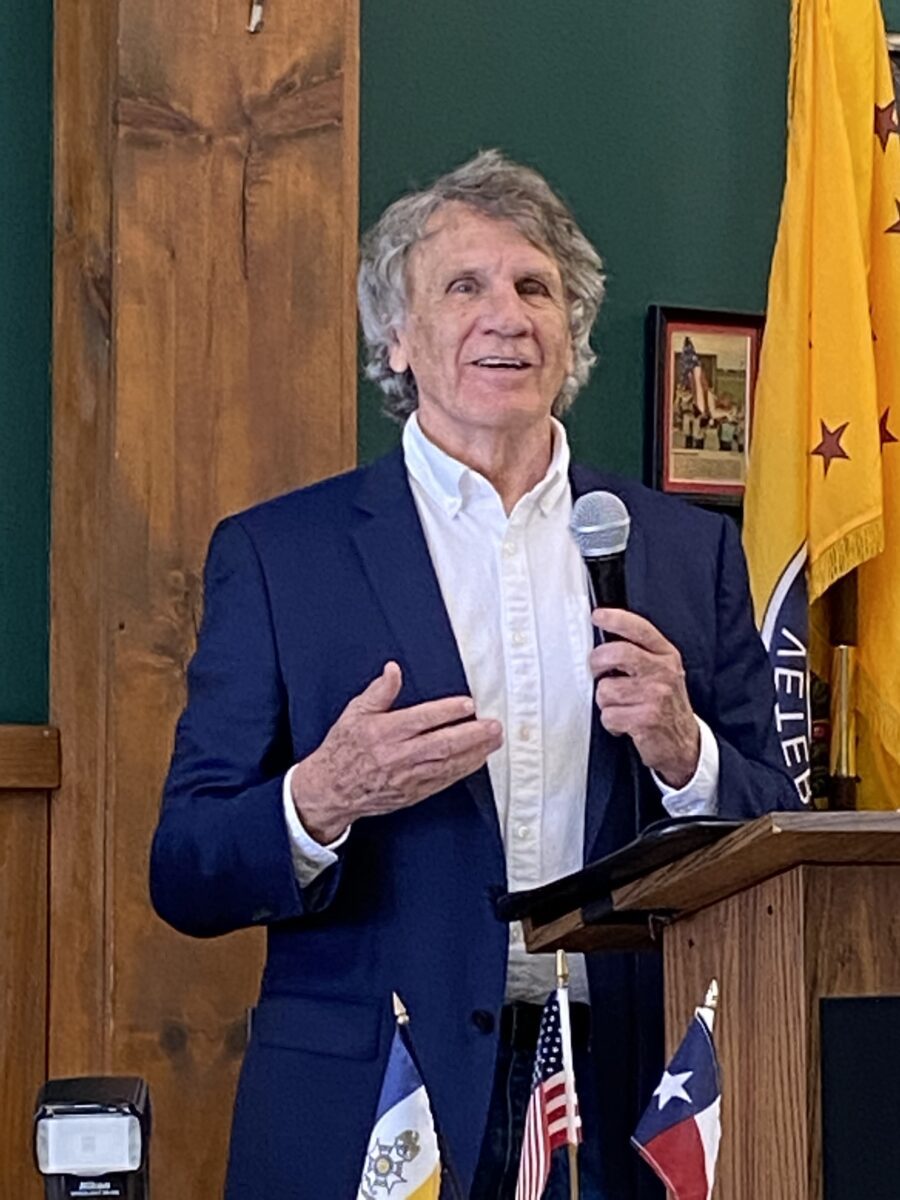![]()

Columbia Historical Museum Photo by Tracy Gupton
Houston Chronicle columnist Joe Holley, left, spoke at Saturday’s meeting of the Texas Sons of the American Revolution Cradle of Texas Chapter in El Campo. Chapter President Carl Wiggins presented Holley with a certificate honoring him for being a 2022 Pulitzer Prize winner.
By Tracy Gupton
Columbia Historical Museum Board Member
It was merely a coincidence that Houston Chronicle columnist Joe Holley spoke to a gathering of Cradle of Texas Sons of the American Revolution members this past Saturday on a similar topic the same day The Facts history columnist Marie Beth Jones wrote about another Mier prisoner from the well-documented 1843 “black bean” incident in her weekend “Brazos Tales” column.
Although the young men these two historians wrote and spoke about were different, the saved-from-the-clutches-of-death scenario the two shared 180 years ago involved the same historical event in early Texas lore. Jones’ December 10th Facts column was about 18-year-old Orlando Phelps, son of Orozimbo Plantation owner Dr. James A.E. Phelps. Orlando was saved from execution by a Mexican firing squad by General Antonio Lopez de Santa Anna, the President of Mexico at the time.
And Holley, part of a Houston Chronicle editorial team that won a Pulitzer Prize earlier this year, spoke to local SAR members at a Saturday noon meeting in El Campo about John Christopher Columbus Hill and “Big Foot” Wallace, saying most people know a little about the 19th Century Texas Ranger “Big Foot” Wallace but few are aware of Hill’s story.
Holley said his mother was born in Bigfoot, Texas, a small town in Frio County named for the Texas Ranger Hall of Fame member William “Big Foot” Wallace. Holley, the author of six books, has been the “Native Texan” columnist for the Houston Chronicle since 2013 and has written stories for his columns about the West Columbia area.
Wallace, Hill and Phelps all survived the “black bean” incident when Texan captives of the Mexican Army were forced to draw beans from an earthen jar containing both white and black beans. Every tenth man, those unfortunate souls who picked the black beans from the jar, was lined up against a wall and shot by a firing squad.
Jones, former managing editor of The Angleton Times and a longtime Facts columnist and author of several historical books herself, wrote that Orlando Phelps drew a black bean and he and the 16 other unlucky Texan soldiers who had done the same “were taken to a separate courtyard, with the understanding that the firing squad would meet them there a bit later.”
Orlando’s father, Dr. Phelps, had allegedly saved the life of General Santa Anna when he was a captive of the Texans following the Battle of San Jacinto in 1836. Santa Anna attempted to take his own life by swallowing poison when he was a prisoner at the Columbia area Patton plantation that today is known as the Varner-Hogg State Park. Dr. Phelps treated Santa Anna at the Phelps family’s Orozimbo Plantation on the Brazos River near what is today East Columbia. The Mexican dictator may well have died from the poison ingested if not for Dr. Phelps’ medical expertise.
It is not known just how close young Orlando Phelps came to being executed with the other 16 Texans who died that day, but a message arrived just in time from Santa Anna, directing that Phelps’ life be spared when the President of Mexico learned that Dr. Phelps’ son was among those Texan prisoners selected for execution.
“Big Foot” Wallace was also a captive among the Mier Prisoners. He luckily picked a white bean, and his life was spared. The three – Hill, Phelps and Wallace – were part of the Somervell Expedition, which Joe Holley wrote in a column was “an ill-conceived effort to invade Mexico and put an end once and for all to Mexican adventurism in the Republic of Texas. After a bloody engagement with Mexican forces that began on Christmas day (1842), the outmanned Texans had been forced to surrender.”
Holley wrote that the Mexican border town of Mier was downriver from Nuevo Laredo. He told those SAR members gathered for lunch at Mikeska’s Barbecue restaurant in El Campo Saturday that John Christopher Columbus Hill was only 13 when he joined his father Asa Hill and older brother Jeffrey, leaving their farm near Fayetteville in September 1842 to head toward San Antonio with other volunteers to join up with General Alexander Somervell’s Texas Army.
The three members of the Hill family eventually reached Laredo on Dec. 7, 1842, and were among about 1,000 Texas volunteers who were heavily outnumbered by the more than 2,000 Mexican soldiers gathered at Mier two weeks later. “Exhausted, running out of ammunition and hearing rumors of Mexican reinforcements on the way, (the Texans) decided to surrender,” Holley wrote in his recent column.
Mexican General Pedro de Ampudia, whose own adopted son “had died an agonizing death a few hours earlier” in the battle against the Texans at Mier, offered to adopt John Hill, feeling sorry for the now 14-year-old who, along with his father and brother, was facing possible execution. Holley said Saturday that young John Hill refused the offer of adoption but chose to stay in Mexico, lived with a foster family and eventually changed his name to Juan Cristobal Columbo Gil and earned a doctorate in engineering and became an esteemed civil engineer.
“In years to come, he would supervise mining operations and lay out a number of Mexico’s railroad lines,” Holley wrote. “He also became a physician who practiced holistic medicine. He and his wife, Augustina, sister of the famous Mexican painter Ramon Sagredo, were the parents of four children.”
Though John Hill was spared due to his youth, Hill’s father, brother and the rest of the Texas captives like “Big Foot” Wallace and Orlando Phelps were marched from Mier some 700 miles toward Mexico City where, on March 13, 1843, they stopped “at a place called Salado” when the decision was made by Santa Anna to have the prisoners draw beans from a jug, resulting in the killing of those who drew the black beans. Those who drew the white beans ended up imprisoned for two years at Perote between Mexico City and Vera Cruz.
“Most made it back to Texas,” Holley wrote, “Asa Hill and son Jeffrey among them.”
Following his release from the Perote prison, “Big Foot” Wallace joined the Texas Rangers under Jack Hays – of early Texas History fame, not the former El Campo Ricebirds and Columbia Roughnecks football coach – and was a Lieutenant in Captain R.A. Gillespie’s Company of Texas Mounted Volunteers in the U.S. Army before again serving as a Ranger during the 1850s.
Marie Beth Jones wrote in her Facts column this past Saturday that Orlando Phelps was released by Santa Anna as a favor to the man who had saved the Mexican dictator’s life while he was held captive at the Orozimbo Plantation near East Columbia. “(Santa Anna) decided to release Orlando,” Jones wrote, “giving him new clothes, $500, and passage by ship to a port near his home. All of these concessions were apparently given to express the recognition the Mexican leader felt Dr. Phelps deserved, both as a physician and as a kind individual for his medical expertise and the kind personal treatment he had provided to the Mexican general.”

Photos courtesy of San Jacinto Museum of History
John Christopher Columbus Hill photographed as a young man in upper photo and as a much older gentleman in lower picture. This young survivor of the Mier Prisoners episode in Texas History died February 16, 1904, at the age of 75. In 1897, he was named an honorary life member of the Texas State Historical Association. In 1855 he married the daughter of a Spanish general and fathered four children with her.


Columbia Historical Museum Photo by Tracy Gupton
Pulitzer Prize winning writer Joe Holley of Austin spoke at Saturday’s meeting of the Texas Sons of the American Revolution Cradle of Texas chapter.
